Without a cabinet for storing dishes, it is almost impossible to imagine any kitchen. The choice of this interior item depends on many important parameters - from the size of the room itself to the system for organizing the storage of utensils.

Types of designs
Cabinets for kitchen utensils are usually divided into three main groups. This piece of furniture can be floor, mounted or corner. Designs have different functionality and are suitable for different rooms, and therefore their choice should be deliberate and determined by many factors. The floor cupboard comes in many variations. The most common are ordinary cabinets, but the same group also includes a wardrobe, and a wardrobe.
Floor constructions are placed either on several legs or on a solid base. Such a cabinet is generally suitable for storing more dishes. In addition, they perfectly serve as a surface for cooking and other work. Since the floor structure has greater stability and the ability to withstand severe loads, it is reasonable to place heavy utensils in it - that is, pans, pans, deep plates and similar objects.



The wall-mounted kitchen cabinet has less capacity than the floor, but, being fixed on the surface of the wall, it saves a significant part of the floor space. Not a single small kitchen, in which it is required to accommodate many things for storage, can do without hinged structures.
Heavy utensils are not allowed to be placed in them, but mugs, glasses, light plates and saucers are perfectly placed on shelves.



Corner kitchen cabinets allow you to wisely use an uncomfortable area. The non-standard length of this module allows you to place a large number of items for storage, but it happens that it differs in inconvenient operation. Corner cabinet can be wall mounted, floor, as well as an individual speaker. These designs are also usually divided into trapezoidal, l-shaped, as well as docking.
It is worth mentioning that sometimes in large kitchens there is also a built-in closet for washing dishes. As a rule, it occupies an existing niche or wall and is a structure similar to the common wardrobe.




Materials of manufacture
For the manufacture of cupboards, it is customary to use various materials. Budget designs are made of Particleboard or MDFas well as inexpensive varieties of wood. More expensive options are already being created from wood. In the design of modern design kitchens metal - such designs are distinguished by reliability, durability and unusual appearance. In most cases wooden modules are complemented by glass, and sometimes the cabinet is even made completely glass.
However, wood remains the most popular material. It has the necessary strength, is environmentally friendly for the inhabitants of the apartment, and also always looks attractive. The material is additionally treated with a protective solution from moisture and exposure to insects, and therefore these problems should not be feared.



Dimensions
Modern kitchen cabinets are made in various shapes and sizes, and therefore to choose the most suitable design for a particular interior is not particularly difficult. For spacious rooms, it is recommended to choose large and solid-looking models, and for small rooms a tall, narrow and compact module is more suitable. Besides, the parameters will depend on how many dishes to place.




The height of a standard cabinet ranges from 30 to 90 centimeters in height, and the depth, as a rule, reaches 30 centimeters. but it is much more correct to select the dimensions for a specific room, that is, to make to order, taking into account all the features of the room.
The optimal width and height of the wall cabinet should be in the range of 30 to 35 centimeters for ease of use. It is important to ensure a reliable fastening system so that it simply does not fall off. Too high a module for utensils is not very practical, as there will be problems using utensils located on the upper shelves.
In the event that a dish dryer is placed in the cabinet, the depth of the module should be equal to the diameter of the largest plate. In general, the best solution for the kitchen is to use cabinets of varying heights, both with open shelves and with blind doors.
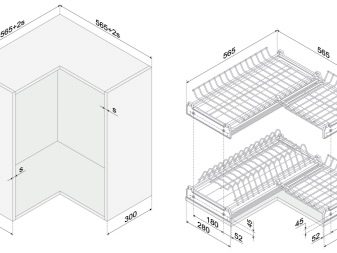



Internal filling
Although it is easiest and fastest to place all the available dishes on the shelves, the presence of a large number of modern storage systems makes it possible to more effectively and aesthetically solve the task. Still, it is customary to keep the plates on the shelves, but instead of the usual ones, it makes sense to purchase special trellised ones that allow you to set objects “on the edge”.
A good solution would be to immediately place a dryer in the module, which is a metal system, under which a tray is installed, where water flows. In floor drawers quite often special dividers are used that prevent the dishes from hitting the walls and between themselves.

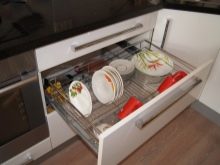

While glasses and glasses are simply put on shelves, cups are much more convenient to place on railing - a special tube with hooks or other holders that are hung from the outside or inside the cabinet.Sometimes hooks are simply fixed on the upper surface of the cabinet, and circles are hung on them by the “ears”. In the floor drawers for storing this type of dishes again used dividers.
Pots are convenient to store in floor cabinets, but in the case of the corner module you will have to purchase an additional retractable system or a rotating “carousel” with swivel shelves.
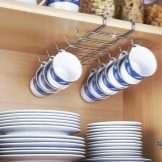

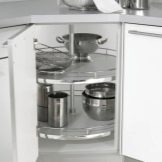
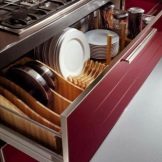
Pans will be conveniently located on rails or in drawers with delimiters. In addition, a well-proven retractable hook system. Covers can be fixed internally on the doors or in special drawers. Many companies also started to create special stands that are placed inside the floor module and are often retractable. A variety of railing systemslooking like net baskets, tubes or hooks.




How to choose?
To choose a successful kitchen cabinet for dishes, you must consider the following nuances:
- the number of planned items for storage;
- dimensions and shapes of the space itself;
- kitchen design style.
For example, some retro design involves the installation of tall windows with glass doors. The same showcase, made of metal, successfully fits into the hi-tech style. Making a kitchen in such a modern style as Scandinavian implies the rejection of wall cabinets and the combination of floor with open shelves.
In any case, the selected cabinet should be comfortable, roomy and consistent with the overall stylistic decision of the room.



Where is better to place?
A freestanding cabinet is most conveniently placed in a wall niche or any similar recess. If this is not possible, then it is worth putting it in a free corner in order to use free space wisely. In other cases, the installation of cabinets should take place in such a way so as not to interfere with movement around the room, as well as the use of all household appliances. Hinged cabinets should be located so that between them and the countertop remained from 50 to 56 centimeters.
The specific height is determined depending on the growth of all family members, and most importantly, the person who will use them most often. The greater the depth of the floor cabinet, the less shall be the gap from the countertop to the hinged module.
To guess with a stylistic decision, and with placement, it is most convenient to immediately purchase a one-piece headset that combines the upper and lower modules. The floor module may have a different number of doors and drawers, the same can be said about hinged ones, so this “volumetric" factor will also have to be taken into account when placing objects in space.
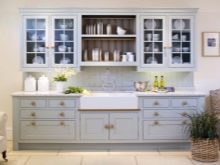


Proper furniture care
The kitchen itself is a room with a very difficult atmosphere. The furniture is periodically exposed to moisture of different temperatures, heavy fumes, splashes of grease and food pieces. This suggests that, on the one hand, it is necessary to acquire sustainable furniture elements, and, on the other hand, to properly care for them.
- You should not cut food directly on the surface without using a special board, jerk boxes sharply, or slam doors. Modules should be regularly cleaned using detergents.
- It is important that the cabinet is protected from direct sunlight, and processing is carried out only with the use of solutions that do not have aggressive components in the composition.
- It is customary to wipe the tree with a dry and soft cloth, and ordinary wet wipes are suitable for plastic panels. If the wooden cabinet turned out to be very dirty, then it makes sense to dilute a degreasing agent in water, then rinse the surface with a damp cloth and be sure to dry everything thoroughly. The stainless steel is easily washed with soapy water and is also necessarily wiped.Perhaps, only glass is a certain exception - such facades can be washed only with the use of appropriate means. Wooden panels, including MDF with chipboard, are recommended to be additionally treated with polish in combination with wax.
- When placing furniture on shelves, it is important not to overload them and place heavier dishes below. The same applies to drawers, the moving elements of which quickly fail in the event of improper operation. Of course, it is necessary to minimize the mechanical impact, as well as the effects of steam and water. Therefore, for example, it is not customary to place cupboards for dishes right above the stove. It also makes sense to further strengthen the drawers with shock absorbers and closers.
The backlight in the kitchen will also not be superfluous. Unstable floors require modules for utensils whose legs are adjustable. Otherwise, both shelves and drawers will lose the required reliability and strength.



About assembling your own kitchen, see the next video.










